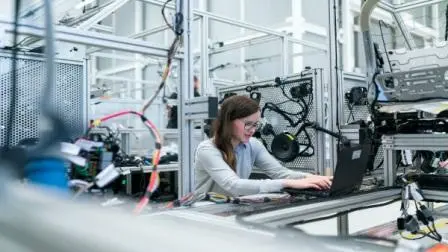In today’s rapidly evolving technological landscape, it’s crucial to examine the impact of ‘Technology and the Environment.’ Let’s explore how technology has both positive and negative effects, aiming for a harmonious future.”
Technology and the Environment: Fostering Positive Impacts
1. Fostering Sustainability th
rough Technology and the Environment
Technology has introduced groundbreaking possibilities, from smartphones connecting the world to smart homes adapting to our needs. The continuous evolution of technology has led to remarkable breakthroughs that have paved the way for new possibilities and amazing opportunities. From the invention of the wheel, which revolutionized transportation, to the marvels of artificial intelligence, which have transformed industries, each advancement has brought us closer to a world where humans and technology coexist seamlessly.
Today, we have smartphones that put the world at
our fingertips, allowing us to communicate and access information effortlessly. Smart homes can adjust to our needs, optimizing energy usage and enhancing our comfort. In the realm of environmental conservation, technology plays a pivotal role. Scientists utilize advanced sensors and satellites to gather data on critical issues such as climate change, deforestation, and pollution. This data serves as a foundation for informed decision-making, helping us protect and conserve our planet.
2. Harnessing Data for Conservation through Technology and the Environment:

One of the most significant positive impacts of technology on the environment is its role in data-driven conservation. Advanced sensors and satellite technology enable scientists to collect vast amounts of data related to climate change, deforestation, and pollution. This data serves as a crucial tool for making informed decisions to protect and conserve our planet.
For instance, scientists can use satellite imagery to monitor changes in the Earth’s climate and track the melting of polar ice caps. They can also employ advanced sensors to measure air and water quality, helping to identify pollution sources and develop strategies to mitigate environmental damage. In the realm of biodiversity conservation, technology aids in tracking and protecting endangered species. Advanced tracking devices and remote sensors allow scientists to monitor animal movements and habitat changes, helping to ensure the survival of vulnerable species.
3. Clean Energy Revolution through Technology and the Environment:
The development of clean and renewable energy sources is another remarkable positive impact of technology on the environment. As the world grapples with the consequences of fossil fuel consumption, technology has facilitated the growth of renewable energy alternatives such as solar and wind power.
Solar panels and wind turbines harness the power of nature to generate electricity without the harmful emissions associated with fossil fuels. The adoption of these clean energy sources reduces our reliance on non-renewable resources and helps combat air pollution. Furthermore, it plays a pivotal role in mitigating the effects of climate change by reducing greenhouse gas emissions.
4. Promoting Green Mobility through Technology and the Environment:
The rise of electric vehicles (EVs) is a notable advancement in sustainable transportation. EVs offer a cleaner and more environmentally friendly alternative to traditional gasoline-powered cars. These vehicles are powered by electricity, which can be generated from renewable sources, further reducing their carbon footprint.
The adoption of EVs has the potential to significantly decrease carbon emissions from the transportation sector, which is a major contributor to air pollution and climate change. Additionally, advancements in battery technology continue to improve the range and efficiency of EVs, making them more accessible and practical for a wider range of consumers.
5. Smart Cities for Resource Optimization
Technology-driven solutions have also transformed the way we plan and manage urban environments. Smart cities leverage technology to optimize resource usage and improve sustainability. These cities employ data analytics, sensors, and automation to enhance various aspects of urban life, from transportation and energy management to waste reduction.
In smart cities, traffic lights adjust in real-time to reduce congestion, minimizing fuel consumption and emissions. Energy-efficient buildings use sensors to regulate lighting, heating, and cooling, leading to significant energy savings. Waste management systems use data to optimize collection routes, reducing fuel consumption and emissions. Overall, smart cities are at the forefront of sustainable urban development, demonstrating how technology can improve the quality of life while reducing environmental impact.
6. Precision Agriculture
Agriculture, a critical component of human survival, has also benefited from technological advancements. Precision agriculture, fueled by technology, is revolutionizing farming practices worldwide. Through the use of smart sensors and data analytics, farmers can monitor soil conditions, moisture levels, and crop health with unprecedented precision.
This level of data-driven decision-making allows farmers to optimize resource usage. They can precisely control irrigation, ensuring that crops receive the right amount of water. Similarly, the application of fertilizers and pesticides can be targeted only where and when needed, minimizing waste and reducing the environmental impact of agriculture. As a result, precision agriculture not only leads to higher crop yields but also reduces the need for harmful chemicals, protecting both the environment and our food supply.
7. Conservation Technologies
Technology has provided powerful tools for the conservation of natural ecosystems. Advanced imaging technologies, such as satellite and drone imagery, have revolutionized our ability to understand and protect delicate ecosystems. Scientists and conservationists can now map and monitor wildlife habitats with unprecedented detail, helping to identify and address threats to endangered species.
For example, satellite imagery can be used to track deforestation in remote rainforests, enabling authorities to take action against illegal logging operations. Drones equipped with high-resolution cameras can monitor the nesting sites of endangered birds, providing valuable data for conservation efforts. Additionally, underwater drones allow researchers to explore and document the health of coral reefs, essential ecosystems threatened by climate change and pollution.
These conservation technologies are crucial for preserving the rich biodiversity of our planet. They empower scientists and conservationists to make informed decisions and take timely action to protect threatened species and ecosystems.
8. Waste Management Innovations
Efficient waste management is essential for reducing the environmental impact of human activities. Technology has introduced innovative recycling technologies that make it possible to sort and process waste more efficiently than ever before. Automated sorting systems use advanced sensors and robotics to separate recyclable materials from general waste, increasing recycling rates and reducing the burden on landfills.
Additionally, waste-to-energy conversion systems represent a promising solution to the problem of organic waste disposal. These systems can convert organic waste, such as food scraps and agricultural residues, into valuable energy sources, including biogas and electricity. This not only reduces the volume of waste in landfills but also provides a sustainable alternative to traditional energy production methods, which often rely on fossil fuels.
Challenges Arising from Technology and the Environment:
1. Electronic Waste (E-Waste) Crisis:
While technology has brought about numerous benefits, it has also given rise to a significant environmental challenge: electronic waste, or e-waste. The rapid pace of technological advancement means that electronic devices quickly become outdated, leading to an alarming accumulation of discarded electronics.
The production and disposal of electronic devices generate e-waste, which poses a substantial environmental hazard. Improper disposal of e-waste can contaminate soil, water, and air, releasing harmful chemicals and toxins into the environment. Each year, the world generates over 50 million metric tons of e-waste, which can contain hazardous materials harmful to the environment if not properly disposed of or recycled.
2. High Energy Consumption:
The increasing reliance on technology has led to a surge in energy consumption. Data centers, internet servers, and electronic devices all require vast amounts of energy to operate. Unfortunately, much of this energy comes from non-renewable sources such as fossil fuels.
The energy-intensive nature of technology contributes to greenhouse gas emissions and exacerbates climate change. As the demand for data and digital services continues to grow, the environmental impact of high energy consumption becomes a pressing concern. Finding sustainable energy solutions for the technology sector is essential to mitigate its contribution to climate change.
3. Habitat Destruction:
As technology fuels rapid urbanization, it frequently results in deforestation, habitat destruction, and biodiversity loss. The growth of urban areas and industrial development can clear forests and transform natural habitats into urban landscapes.
Habitat destruction is particularly detrimental to wildlife and plant species that depend on these ecosystems for survival. The loss of biodiversity can disrupt ecosystems, leading to imbalances in predator-prey relationships and the spread of invasive species. It is crucial to strike a balance between development and environmental preservation to minimize the negative impact on natural habitats.
Also Read : Krishna Janmashtami 2023: A Divine Celebration
Mitigating the Adverse Effects of Technology and the Environment:
1. Responsible Innovation and Recycling:
To mitigate the negative impact of technology on the environment, it is essential to promote responsible product design and recycling programs. Manufacturers can play a significant role in reducing e-waste by designing products with longevity and recyclability in mind.
Consumers can also contribute by responsibly disposing of their electronic devices through recycling programs. Government regulations and incentives can further encourage the recycling and responsible disposal of e-waste.
2. Energy Efficiency and Renewable Sources:
Embracing energy-efficient technology and shifting to renewable energy sources are critical steps in reducing the carbon footprint of the technology sector. Companies and data centers can invest in energy-efficient infrastructure and data management practices to minimize energy consumption.
Governments can incentivize the adoption of renewable energy sources by providing subsidies and tax incentives for businesses and individuals. Transitioning to renewable energy not only reduces greenhouse gas emissions but also creates a sustainable energy future.
3. Conscious Urban Planning
Balancing development and environmental preservation requires conscious urban planning. City planners can prioritize eco-sensitive infrastructure development that minimizes habitat destruction and promotes sustainability.
Designing green spaces within urban areas, implementing wildlife corridors, and preserving natural landscapes are essential steps in maintaining a balance in the ecosystem. Sustainable urban planning can help reduce the environmental impact of urbanization and infrastructure development.
Conclusion:
The impact of technology on the environment is a multifaceted and complex topic. While it brings immense possibilities for a sustainable future, we must also address its negative repercussions. As we continue to embrace technological advancements, it is our responsibility to do so with a keen awareness of their environmental consequences.
By promoting responsible innovation, recycling, and sustainable practices, we can minimize the negative effects of technology on the environment. Embracing energy-efficient technology and renewable energy sources will further reduce our carbon footprint. Additionally, conscious urban planning and eco-sensitive infrastructure development will help maintain a balance in the ecosystem.
In conclusion, technology and the environment can coexist harmoniously when we make informed choices and prioritize sustainability. Let us shape a future where progress and conservation go hand in hand, preserving the natural beauty of our planet for generations to come.









Your article helped me a lot, is there any more related content? Thanks!